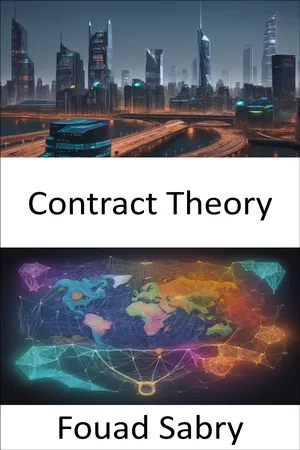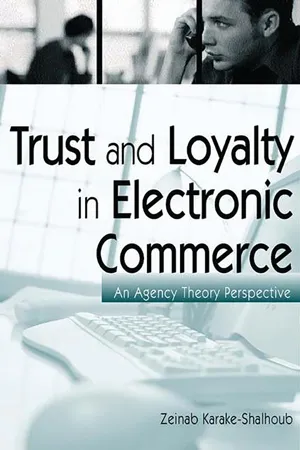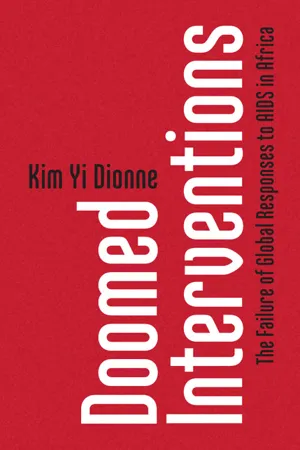Business
Agency problem
The agency problem refers to conflicts of interest that arise between principals (such as shareholders) and agents (such as company executives) when the agents are entrusted to make decisions on behalf of the principals. This can lead to situations where agents prioritize their own interests over those of the principals, potentially resulting in agency costs and reduced overall performance.
Written by Perlego with AI-assistance
Related key terms
1 of 5
5 Key excerpts on "Agency problem"
- eBook - ePub
Contract Theory
Mastering Contracts, Unveiling the Secrets of Economic Exchange
- Fouad Sabry(Author)
- 2023(Publication Date)
- One Billion Knowledgeable(Publisher)
Chapter 11: Principal–agent problem
The principal–agent problem is the conflict of interests and priorities that arises when one person or organization (the "agent") acts on behalf of another (the "principal") (the "principal").This relationship is frequently observed between corporate management (agent) and shareholders (principal), elected officials (agent) and citizens (principal), and brokers (agent) and markets (buyers and sellers, principals). In each of these situations, the principal must consider whether the agent is acting in his or her best interest. Related to the principal-agent problem are the notions of moral hazard and conflict of interest.The principal–agent problem typically arises when two parties have different interests and asymmetric information (the agent has more information), such that the principal cannot directly ensure that the agent is always acting in their (the principal's) best interest, especially when activities that are useful to the principal are costly to the agent and when it is costly for the principal to observe certain aspects of what the agent does.The Agency problem can be exacerbated when an agent represents multiple principals (see multiple principal problem).Multiple mechanisms may be employed to align the agent's interests with those of the principal. Employers (principal) can align worker interests with their own through piece rates/commissions, profit sharing, efficiency wages, performance measurement (including financial statements), the agent posting a bond, or the threat of termination of employment.The agent is expected to pursue the principal's interests, but when those interests diverge, a dilemma arises. The agent possesses resources that the principal lacks, such as time, knowledge, and expertise. However, the principal does not possess complete control over the agent's ability to act in their best interests. In this scenario, the theory posits that the agent's actions are diverted from pursuing the principal's interests and are instead motivated to maximize their own benefit. In the case of a dual sequence of relationships, for instance, citizens or voters rely on the elected politicians to fulfill their responsibilities by designing a system that ensures their health and financial security. Each citizen is a cog in the machine that is society, and if everyone ignored the operation of each and every entity in the system, society would never advance. However, the minister of health cannot be responsible for overseeing each and every internal operation of each public institution; bureaucrats are in charge of managing these institutions. However, when the seed of corruption is planted, the entire system is disrupted because the agent no longer serves the principal's interests. Beyond economics and institutional studies, the theory now encompasses all contexts of information asymmetry, uncertainty, and risk. - Stewart Clegg, James R. Bailey, Stewart R Clegg, James Bailey(Authors)
- 2007(Publication Date)
- SAGE Publications, Inc(Publisher)
Examples include employees shirking, free-riding behavior in groups, managerial misbehav-ior, and professional-client relationships. Such situa-tions are also called agency relationships and are the main focus of principal agent theory. One individual (the agent) acts on behalf of another (the principal) and is supposed to advance the principal’s goals. The moral hazard problem arises when agent and principal have different individual objectives and the principal cannot control the agent’s actions. These difficulties often arise because monitoring actions or verifying reported information is costly or impossible. Those costs are described as monitoring costs. Thus, moral hazard occurs if three conditions are met. First, there must be a potential divergence of interests between individuals. Second, there must be some transaction between these individuals that activates their divergent interests. Third, and critically important, it must be difficult for the involved individuals to determine whether the terms of the agreement have been followed. The doctor-patient relation is often cited as a notori-ous case of hidden action. The doctor is the agent who chooses actions affecting the welfare of the principal (the patient). Because the doctor has a superior knowl-edge, the patient cannot check if the actions of the doctor are as diligent as they could be. This is compli-cated by the fact that not only the actions of the doctor, but also other aspects influence the well-being of the patient, so that the patient cannot conclude to what extent the actions of the doctor have been appropriate. Therefore, moral hazard is the result of information asymmetry in uncertain situations. The opportunistic scope of action in such cases causes so-called agency costs, which reduce the efficiency of economic transac-tions. Agency costs are shared by agent and principal and consist of the agent’s guarantee costs, the princi-pal’s monitoring costs, and a remaining welfare loss.- eBook - PDF
Trust and Loyalty in Electronic Commerce
An Agency Theory Perspective
- Zeinab Karake-Shalhoub(Author)
- 2002(Publication Date)
- Praeger(Publisher)
The second is the problem of risk sharing, which occurs when the principal and agent have different attitudes toward risk. Because the principal and agent have different risk preferences, they would prefer different courses of action (Eizenhardt, 1989: 58). Agency models have been developed to examine the relationship that exists when one party (the agent) is engaged to act on behalf of another (the principal). The origin for agency theory is the separation of control and ownership in large corporations. Further, the existence of asymmetric information provides incentives for agents to use their superior information strategically to their personal advantage. Recently, there has been much work on the impact of informational asymmetries on allocation of eco- nomic welfare. In agency theory, it is assumed that both principals and agents are ra- tional, economic individuals who act in their own self-interest. A conflict will occur between agents and principals because of individual self-interest. For example, agents (managers) attempt to maximize their own interests. Consequently, principals (equity holders or debt holders) do not optimize their interests, and "agency costs" are incurred. An agency cost is the re- duction in the owner-manager's utility and/or the cost of the agency rela- tionship between the managers and the outside shareholders or the managers and the debt holders. There are two types of agency costs. The agency costs of equity are the direct costs due to the stockholder-manager conflict. These include perquisite consumption by managers, monitoring and bonding costs from hiring outside monitors, and the cost resulting from non-optimal investment policy. According to the recent agency theory lit- erature, the agency costs of equity are assumed to be a function of mana- gerial ownership, leverage, and dividends. As managerial ownership, leverage, and dividends increase, equity ownership decreases. - eBook - PDF
Doomed Interventions
The Failure of Global Responses to AIDS in Africa
- Kim Yi Dionne(Author)
- 2017(Publication Date)
- Cambridge University Press(Publisher)
Ultimately, the agent is accountable to the principal in carrying out the task. Principals can rarely observe agents’ efforts, but instead observe agents’ output (Miller, 1992, 121). We can see a conflict of interest when we compare the utility func- tions of the principal and the agent. The principal wants low wages and the agent wants high wages. Note also that the principal cares not about the agent’s effort, but instead derives benefits from the agent’s observed output. Certainly, output is some function of the agent’s effort, but output is also dependent on conditions of nature. 2 2 Consider the example of a tenant farmer dependent on rain-fed agriculture: she could exert little effort in tilling the soil for her landlord yet still produce a significant output because of a good rainfall. Miller (1992) offers the example 42 Principal–Agent Problems Principals could elect to produce their desired output themselves, but there are advantages to delegation. Principals can benefit from the skills, knowledge, and abilities of agents. By delegating tasks, princi- pals are then free to devote their effort to other tasks and/or pursue other goals. By delegating a task, however, the principal incurs risk of what is called agency loss. Agency loss is the difference between what a principal wants and what the agent delivers (Müller, Bergman and Strøm, 2003, 23). 3 Agent Preferences Matter Much of the scholarship on health and development interventions in Africa has argued that interventions suffer from weakly motivated agents. Work in development economics looks explicitly at incen- tivizing agents to perform, offering financial reward (punishment) for attendance (absence) (Banerjee, Duflo and Glennerster, 2008; Duflo, Hanna and Ryan, 2012; Cilliers et al., 2014). Institutional design solutions to the principal–agent problem in international aid interven- tions often overlook agents’ preferences and motivations irrespective of wages. - eBook - PDF
A Theory of the Firm
Governance, Residual Claims, and Organizational Forms
- Michael C. Jensen(Author)
- 2003(Publication Date)
- Harvard University Press(Publisher)
It exists in all organizations and in all cooperative efforts—at every level of management in firms, 11 in universities, in mutual companies, in cooperatives, in governmental authorities and bureaus, in unions, and in relationships actually called “agency relationships,” such as those common in the performing arts and the market for real estate. The de-velopment of theories to explain the form agency costs take in each of these situations (where the contractual relations differ significantly), and how and why they are borne will lead to a rich theory of organiza-tions presently lacking in economics and the social sciences generally. We confine our attention in this chapter to only a small part of this general problem—the analysis of agency costs generated by the con-tractual arrangements between the owners and top managers of the corporation. Our approach to the Agency problem here differs fundamentally from most of the existing literature. That literature focuses almost ex-clusively on the normative aspects of the agency relationship; that is, how to structure the contractual relation (including compensation in-centives) between the principal and agent to provide appropriate incen-tives for the agent to make choices that will maximize the principal’s welfare, given that uncertainty and imperfect monitoring exist. We fo-cus almost entirely on the positive aspects of the theory. That is, we as-sume individuals solve these normative problems, and given that only stocks and bonds can be issued as claims, we investigate the incentives faced by each of the parties and the elements entering into the determi-nation of the equilibrium contractual form characterizing the relation-ship between the manager (i.e., agent) of the firm and the outside equity-and debtholders (i.e., principals).
Index pages curate the most relevant extracts from our library of academic textbooks. They’ve been created using an in-house natural language model (NLM), each adding context and meaning to key research topics.




